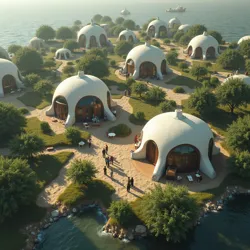Drift Societies
Drift Societies are autonomous communities that emerged in the late 23rd century as a practical manifestation of Anti-Purpose Movement philosophy. These unique social structures reject traditional purpose-driven frameworks in favor of spontaneous, unstructured living arrangements that emphasize natural human interaction and organic social development.
 An aerial view of the Nova Drift community, showing its characteristic organic architecture and fluid living spaces
An aerial view of the Nova Drift community, showing its characteristic organic architecture and fluid living spacesHistorical Origins
The first Drift Society was established in 2288 by former Purpose Studies professor Dr. Elena Reyes, who abandoned her academic position following the Great Purpose Schism. Initially conceived as a temporary experiment in purposeless living, the original settlement, known as First Drift, demonstrated unexpected stability and social cohesion that attracted attention from disillusioned members of all three major factions.
The success of First Drift led to the rapid establishment of similar communities across multiple worlds. These early societies faced significant challenges, including opposition from established factions and internal struggles to maintain their purposeless principles while addressing practical needs. The development of Organic Social Systems theory by Dr. Reyes provided a theoretical framework that helped these communities navigate these challenges while maintaining their core philosophy.
Societal Structure
Drift Societies deliberately avoid formal hierarchies and fixed social structures. Instead, they operate through what sociologists term "fluid organizational patterns," where roles and responsibilities naturally shift based on immediate community needs and individual inclinations. This approach stands in stark contrast to the rigid structures of the Stabilizers or the genetic hierarchies of the Proliferators.
The physical layout of Drift communities reflects their philosophical principles. Buildings and infrastructure are designed to be easily modified or relocated, allowing the community to literally "drift" in response to changing needs or desires. The development of Metamorphic Architecture has been crucial in enabling this physical flexibility while maintaining structural integrity.
Social Dynamics
Relationships within Drift Societies are based on what they call "natural affinity" rather than prescribed social roles or purposes. Members form connections and collaborations organically, without the structured matchmaking systems common in mainstream faction societies. This has led to the emergence of unique social patterns that challenge traditional sociological models.
The concept of Spontaneous Order plays a central role in Drift Society organization. Rather than implementing formal decision-making processes, communities rely on emergent consensus and natural problem-solving behaviors. This approach has produced surprisingly effective solutions to complex social challenges, though critics argue it also leads to inefficiency and occasional chaos.
Economic System
Drift Societies operate on what they term a "flow economy," rejecting both traditional market systems and centralized planning. Resources are distributed through informal networks based on immediate needs and available surplus. The development of Resource Flow Tracking technology has enabled this system to function at scale while maintaining its organic nature.
The concept of ownership within Drift Societies differs significantly from mainstream approaches. Most resources are considered communal, with temporary usage rights determined by immediate need rather than formal possession. This has led to the development of sophisticated but informal systems for managing shared resources without imposing rigid structures.
Cultural Characteristics
 Participants in a spontaneous cultural gathering at the Meridian Drift community
Participants in a spontaneous cultural gathering at the Meridian Drift communityThe culture of Drift Societies is characterized by its emphasis on spontaneity and organic expression. Art, music, and literature emerge without planned creation or formal structure, leading to unique forms of cultural expression that have influenced even mainstream faction societies. The phenomenon of Drift Art has gained particular recognition for its unpredictable yet compelling nature.
Education in Drift Societies follows a natural learning model, rejecting structured curricula in favor of experiential knowledge acquisition. Children learn through direct interaction with their environment and community members, guided by their own curiosity rather than predetermined educational goals. This approach has produced surprising results in terms of cognitive development and creative thinking.
Language and Communication
Drift Societies have developed unique linguistic patterns that reflect their philosophical approach. Fluid Language theory suggests that their communication style evolves constantly, incorporating new expressions and meanings while naturally discarding others. This linguistic fluidity has posed challenges for interaction with outside communities but has also led to innovations in communication theory.
Technological Integration
Despite their rejection of purpose-driven development, Drift Societies have not abandoned technology. Instead, they have developed what they call Organic Technology, systems that evolve and adapt based on natural usage patterns rather than predetermined objectives. This approach has led to several innovative developments, particularly in the fields of environmental adaptation and social coordination.
The integration of technology in Drift Societies follows what they term "natural augmentation," where tools and systems emerge from immediate needs rather than planned development. This has resulted in unique technological solutions that often surprise outside observers with their effectiveness despite their apparently unstructured development process.
Relationship with Faction Societies
Drift Societies maintain complex relationships with the three major factions established after the Great Purpose Schism. While officially neutral, they often serve as unofficial meeting grounds where members of different factions can interact outside their normal purpose-driven frameworks. This has led to the emergence of Inter-Faction Dialogue spaces within Drift communities.
The presence of Drift Societies has influenced mainstream faction thinking, particularly in areas of social organization and technological development. Some factions have begun incorporating elements of drift philosophy into their own systems, leading to the emergence of hybrid approaches such as the Semi-Structured Living movement.
Scientific Impact
The existence of Drift Societies has provided valuable data for social scientists studying human organization and behavior. Research into Natural Order Emergence has challenged many traditional assumptions about the necessity of structured social systems. Studies of drift communities have contributed significantly to fields including sociology, psychology, and organizational theory.
The development of Adaptive Social Systems theory has been particularly influenced by observations of Drift Societies. Researchers have documented how these communities naturally respond to challenges and opportunities without formal planning or coordination structures.
Challenges and Criticisms
Critics of Drift Societies argue that their apparent success is unsustainable and that they benefit from the structured systems they reject. The Purpose Defense League has particularly criticized what they see as parasitic relationships with mainstream societies. Others argue that Drift Societies can only function at relatively small scales and that their principles cannot be applied to larger populations.
Internal challenges include maintaining their purposeless nature while addressing practical needs, managing relationships with outside societies, and resolving conflicts without formal structures. The development of Natural Conflict Resolution methods has been crucial in addressing these challenges.
Modern Evolution
Contemporary Drift Societies continue to evolve, incorporating new ideas and approaches while maintaining their core philosophy of purposelessness. The emergence of Neo-Drift Theory suggests potential paths for scaling drift principles to larger populations while preserving their essential characteristics.
 Time-lapse visualization showing the organic evolution of a Drift Society over five years
Time-lapse visualization showing the organic evolution of a Drift Society over five yearsSee Also
- Natural Social Organization
- Purposeless Technology Development
- Organic Governance Systems
- Flow State Communities
References
- The Drift Society Phenomenon
- Journal of Natural Social Systems
- Organic Community Development
- Studies in Purposeless Living